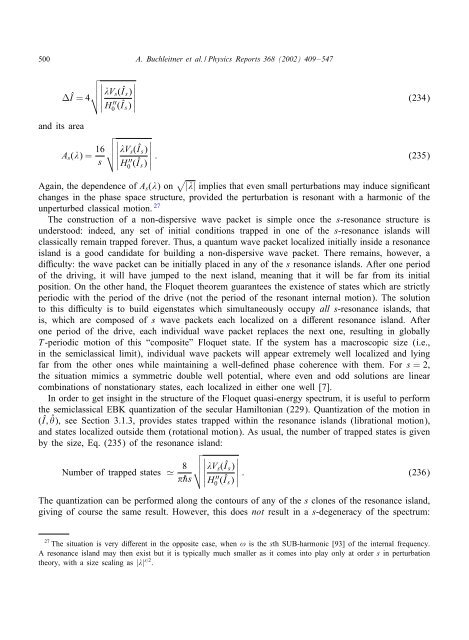Non-dispersive wave packets in periodically driven quantum systems
Non-dispersive wave packets in periodically driven quantum systems
Non-dispersive wave packets in periodically driven quantum systems
Create successful ePaper yourself
Turn your PDF publications into a flip-book with our unique Google optimized e-Paper software.
500 A. Buchleitner et al. / Physics Reports 368 (2002) 409–547<br />
and its area<br />
<br />
<br />
<br />
Î =4<br />
Vs(Î s)<br />
<br />
H ′′<br />
0 (Î <br />
<br />
<br />
<br />
s) <br />
As( )= 16<br />
s<br />
(234)<br />
<br />
<br />
<br />
<br />
Vs(Î s)<br />
<br />
H ′′<br />
0 (Î <br />
<br />
<br />
: (235)<br />
s) <br />
Aga<strong>in</strong>, the dependence of As( )on | | implies that even small perturbations may <strong>in</strong>duce signi cant<br />
changes <strong>in</strong> the phase space structure, provided the perturbation is resonant with a harmonic of the<br />
unperturbed classical motion. 27<br />
The construction of a non-<strong>dispersive</strong> <strong>wave</strong> packet is simple once the s-resonance structure is<br />
understood: <strong>in</strong>deed, any set of <strong>in</strong>itial conditions trapped <strong>in</strong> one of the s-resonance islands will<br />
classically rema<strong>in</strong> trapped forever. Thus, a <strong>quantum</strong> <strong>wave</strong> packet localized <strong>in</strong>itially <strong>in</strong>side a resonance<br />
island is a good candidate for build<strong>in</strong>g a non-<strong>dispersive</strong> <strong>wave</strong> packet. There rema<strong>in</strong>s, however, a<br />
di culty: the <strong>wave</strong> packet can be <strong>in</strong>itially placed <strong>in</strong> any of the s resonance islands. After one period<br />
of the driv<strong>in</strong>g, it will have jumped to the next island, mean<strong>in</strong>g that it will be far from its <strong>in</strong>itial<br />
position. On the other hand, the Floquet theorem guarantees the existence of states which are strictly<br />
periodic with the period of the drive (not the period of the resonant <strong>in</strong>ternal motion). The solution<br />
to this di culty is to build eigenstates which simultaneously occupy all s-resonance islands, that<br />
is, which are composed of s <strong>wave</strong> <strong>packets</strong> each localized on a di erent resonance island. After<br />
one period of the drive, each <strong>in</strong>dividual <strong>wave</strong> packet replaces the next one, result<strong>in</strong>g <strong>in</strong> globally<br />
T -periodic motion of this “composite” Floquet state. If the system has a macroscopic size (i.e.,<br />
<strong>in</strong> the semiclassical limit), <strong>in</strong>dividual <strong>wave</strong> <strong>packets</strong> will appear extremely well localized and ly<strong>in</strong>g<br />
far from the other ones while ma<strong>in</strong>ta<strong>in</strong><strong>in</strong>g a well-de ned phase coherence with them. For s =2,<br />
the situation mimics a symmetric double well potential, where even and odd solutions are l<strong>in</strong>ear<br />
comb<strong>in</strong>ations of nonstationary states, each localized <strong>in</strong> either one well [7].<br />
In order to get <strong>in</strong>sight <strong>in</strong> the structure of the Floquet quasi-energy spectrum, it is useful to perform<br />
the semiclassical EBK quantization of the secular Hamiltonian (229). Quantization of the motion <strong>in</strong><br />
(Î; ˆ ), see Section 3.1.3, provides states trapped with<strong>in</strong> the resonance islands (librational motion),<br />
and states localized outside them (rotational motion). As usual, the number of trapped states is given<br />
by the size, Eq. (235) of the resonance island:<br />
Number of trapped states 8<br />
<br />
<br />
<br />
<br />
Vs(Î s)<br />
<br />
˝s H ′′<br />
0 (Î <br />
<br />
<br />
: (236)<br />
s) <br />
The quantization can be performed along the contours of any of the s clones of the resonance island,<br />
giv<strong>in</strong>g of course the same result. However, this does not result <strong>in</strong> a s-degeneracy of the spectrum:<br />
27 The situation is very di erent <strong>in</strong> the opposite case, when ! is the sth SUB-harmonic [93] of the <strong>in</strong>ternal frequency.<br />
A resonance island may then exist but it is typically much smaller as it comes <strong>in</strong>to play only at order s <strong>in</strong> perturbation<br />
theory, with a size scal<strong>in</strong>g as | | s=2 :











